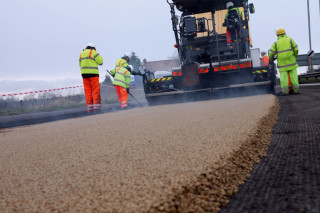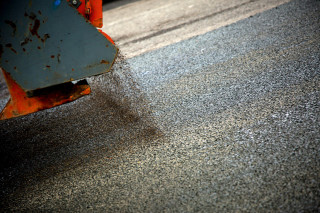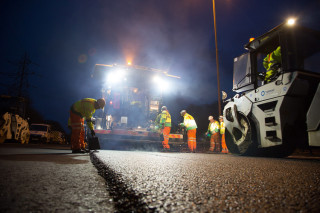Pavements and parliament may seem unlikely bedfellows, but the condition of our roads appears to be moving higher up the political agenda. If there was ever any doubt, we need only look at the pressure applied to the highways industry by both politicians and clients to deliver projects robustly, efficiently and economically, all while reducing disruption to the road user.
This downward pressure is only likely to grow as local authorities continue to tighten purse strings and Highways England’s Roads Programme, with its focus on reducing costs and delivery times, gears up its activity in 2020. With so many projects across the strategic network set to come online in the next few years, now is the time for the industry to rise to the challenge.
Key to managing the increased expectations of policymakers, clients and road users is improved procurement and the implementation of ‘smart’ strategies to drive ambitious projects and programmes. Advances in asphalt technology have meant contractors and suppliers are helping to bring forward new ideas and innovations that can significantly contribute to meeting demanding productivity targets.
Investment in R&D has led to the development of a variety of bespoke asphalts designed to meet the most pressing challenges, including lower carbon footprints, minimised public disruption and faster completion times. Suppliers are anxious to demonstrate to clients the rewards of specifying new products that often break the mould and challenge traditional material usage.
Among these new asphalt technologies is Ultigrip, a new skid-resistant asphalt recently developed by Tarmac, which promises improved safety and enhanced customer experience while delivering whole-life cost savings.
Tarmac’s national technical director Brian Kent explains the rationale for its development: “Providing safe and secure roads is always the number one priority for highways authorities. It’s especially crucial that high-risk locations such as approaches to pedestrian crossings and slip roads, as well as exposed rural routes and motorways, are surfaced with the most appropriate materials available”.
He adds that materials producers have a responsibility to understand the needs of both their client and the road user. “With growing demand for durable skid-resistant products where conventional asphalt provides an insufficient level of grip, we identified an opportunity to create a new high-friction product to extend an asset’s lifecycle, minimise the maintenance burden and reduce the whole-life costs of maintaining highways assets,” says Kent.
Other high-friction surfaces already exist, of course, but Tarmac reckons that Ultigrip is unique. “Unlike traditional products, its skid resistant properties are not added at the end of the surfacing process but are intrinsic to the mix,” says Kent. A calcined bauxite aggregate and a durable clear binder are combined to offer a durable, textured finish and reduce the risk of skidding.

More commonly used in the refractory industry, calcined bauxite is made by heating bauxite ore in a kiln to temperatures in excess of 1,200°C. The abrasive physical and mechanical properties of the material make it ideal for use in high-friction surfaces.
To ensure the asphalt can deliver in terms of its durability and longevity, a special polymer-modified binder is used. This makes the mix easy to compact, robust and transportable over longer distances without compromising its performance. The binder can also be mixed with coloured pigments where a more distinctive appearance is required – for example on the approach to a busy junction.
High-friction properties aren’t the only benefit of the new asphalt, however; lifetime cost reduction was also a key consideration at the development stage.
“Faced with continuing budgetary challenges, highways authorities are being required to deliver pavement renewal projects that are cost effective, as well as hard-wearing and safe,” explains Kent. “Most traditional anti-skid asphalts typically last between two to four years and can be expensive to replace”.
Kent says that UltiGrip lasts on average more than three times longer than similar surfaces, reducing the maintenance burden over its service lifetime. Another benefit is that it can be laid in a single pass, meaning that operatives spend less time on site, reducing their exposure to site hazards and reducing labour costs in both the short and long-term.
According to Tarmac, the longer-lasting surface quality also reduces regular replacement cycles, bringing advantages to road users by minimising disruption. Fewer interventions also limits potential damage occurring to the underlying surface layers during maintenance and the associated costs for this remediation.

Being harder-wearing than existing surfaces, Ultigrip reduces the likelihood of accidents which, in turn, can mitigate against third-party legal claims.
‘If it sounds too good to be true…’ goes the old adage. But Tarmac says that its new anti-skid asphalt is a proven technology that has already been put to effective use on a number of schemes across the UK.

For instance, Ultigrip provided the answer to a challenging brief on the A64 in Yorkshire, where Highways England needed to deliver a durable, anti-skid asphalt on a busy slip road late last year. The junction with the A1237 outside York had been flagged-up as in urgent need of improvement following an increase in the number of traffic accidents being recorded.
Working in collaboration with principal contractor A-one+, the project team was briefed to find a solution that would replace the existing, worn high-friction surface with a more durable asphalt, all the while delivering better whole-life performance, boosting safety and minimising unplanned delays.
Andrew Sharp, programme development manager for A-one+, comments: “Finding a safe and robust product that would suit the project’s requirements was essential but it was also crucial that once we had completed the job there would be no additional requirement to revisit the site for regular maintenance.
“We laid approximately 250 tonnes of UltiGrip bauxite asphalt after having calculated the financial and time savings that it would deliver over its lifetime, even though the upfront costs were initially greater than a conventional solution. When you factor-in the comparative reduced amount of maintenance, the whole-life benefits are impressive”.
Sharp says that these benefits are calculated to include a £370,000 reduction in whole-life costs, 28 fewer days of closure and 2,800 hours of labour saved over the lifetime of the new surface.
Since the project’s completion last year the new asphalt has performed beyond expected standards, providing better visibility, strength and safety.
“The finished surface will stand up to the task and require little or no maintenance for many years to come,” says Brian Kent. “With lower whole-life construction costs and an increased lifespan, we’ve also been able to demonstrate benefits in terms of operator safety and a reduction disruption for our local residents”.
Besides this project near York, Tarmac has supplied hundreds of tonnes of UltiGrip on sites across the country, including on the exposed Woodhead Pass – a notoriously busy and dangerous stretch of the A628 in the Peak District.
This article was first published in the May 2018 issue of The Construction Index magazine, which you can read for free at http://epublishing.theconstructionindex.co.uk/magazine/may2018/
UK readers can have their own copy of the magazine, in real paper, posted through their letterbox each month by taking out an annual subscription for just £50 a year. See www.theconstructionindex.co.uk/magazine for details.
Got a story? Email news@theconstructionindex.co.uk



